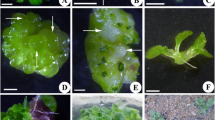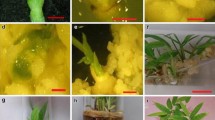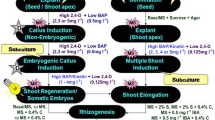Abstract
Calli were initiated from leaf segments (~0.5 × 0.5 cm) of daylily incubated on Murashige and Skoog (MS) (1962) medium supplemented with 2,4-dichlorophenoxyacetic acid (2.4-D), and either benzyladenine (BA) or thidiazuron (TDZ). The highest frequency of callus induction was observed on medium with 6.79 μM 2,4-D plus either 4.55 or 6.81 μm TDZ. A period of callus maintenance on medium containing 5.37 μM naphthaleneacetic acid (NAA) plus 2.22 or 4.44 μM BA was necessary following induction to improve the quality of the callus, and significantly increase the frequency of embryogenic-like callus formation and shoot regeneration once calli were transferred to light. Over 70% of the regenerated shoots produced roots on ½ strength MS medium lacking plant growth regulators. The regenerated plantlets were successfully transferred into soil and acclimatized in growth rooms. This is the first report showing that leaf segments can be used for daylily regeneration.

Similar content being viewed by others
References
AHS (2009) Online daylily cultivar database: http://www.daylilydatabase.org/ Am Hemerocallis Soc
Altpeter F, Posselt UK (2000) Improved plant regeneration from cell suspensions of commercial cultivars, breeding- and inbred lines of perennial ryegrass (Lolium perenne L.). J Plant Physiol 156:790–796
Apps DA, Heuser CW (1975) Vegetative propagation of hemerocallis—inducing tissue culture. Proc Int’l Plt Prop Soc 25:362–367
Bhandary RM, Whitwell T, Briggs J (1997) Growth of containerized landscape plants is influenced by herbicides residues in irrigation water. Weed Technol 11:793–797
Chen JX, Hall DE, De Luca V (2005) Effects of the growth retardant Paclobutrazol on large-scale micropropagation of daylily (Hemerocallis spp.). In Vitro Cell Dev Biol 41:58–62
Corredoira E, Ballester A, Vieitez AM (2008) Thidiazuron-induced high-frequency plant regeneration from leaf explants of Paulownia tomentosa mature trees. Plant Cell Tiss Organ Cult 95:197–208
Duncan DB (1955) Multiple range and multiple F test. Biometrics 11:1–42
Hernandez JR, Palm ME, Castlebury LA (2002) Puccinia hemerocallidis, cause of daylily rust, a newly introduced disease in the Americas. Plant Dis 86:1194–1198
Heuser CW, Apps DW (1976) In vitro plantlet formation from flower petal explants of Hemerocallis cv. ‘Chipper Cherry’. Can J Bot 54:610–616
Heyser JW, Dykes TA, Demott KJ, Nabors MW (1983) High-frequency, long-term regeneration of rice from callus-culture. Plant Sci Lett 29:175–182
Huetteman A, Preece EJ (1993) Thidiazuron: a potent cytokinin for woody plant tissue culture. Plant Cell Tiss Org Cult 33:105–119
Koroch A, Juliani HR, Kapteyn J, Simon JE (2002) In vitro regeneration of Echinacea purpurea from leaf explants. Plant Cell Tiss Organ Cult 69:79–83
Lan TH, Hong PI, Huang CC, Chang WC, Lin CS (2009) High-frequency direct somatic embryogenesis from leaf tissues of Drimiopsis kirkii Baker (giant squill). In Vitro Cell Dev Biol 45:44–47
Li YH, Windham MT, Trigiano RN, Fare DC, Spiers JM, Copes WE (2007) Microscopic and macroscopic studies of the development of Puccinia hemerocallidis in resistant and susceptible daylily cultivars. Plant Dis 91:664–668
Mims CW, Rodriguez-Lother C, Richardson EA (2002) Ultrastructure of the host-pathogen interface in daylily leaves infected by the rust fungus Puccinia hemerocallidis. Protoplasma 219:221–226
Munson RW (1989) Hemerocallis, the Daylily Journal. Timber Press, Portland
Murashige T, Skoog F (1962) A revised medium for rapid growth and bioassays with tobacco tissue cultures. Physiol Plant 15:473–497
Owings AD, Holcomb GE, Broyles CA, Gray AL, Bush EW (2007) Final summary of all-america daylily evaluations: rust observations, flowering, and landscape performance. Hortscience 42:445–446
Prakash S, Elangomathavan R, Seshadri S, Kathiravan K, Ignacimuthu S (2004) Efficient regeneration of Curcuma amada Roxb. plantlets from rhizome and leaf sheath explants. Plant Cell Tiss Organ Cult 78:159–165
Rossman A (2009) The impact of invasive fungi on agricultural ecosystems in the United States. Biol Invasions 11:97–107
Sticklen MB, Rumpho RE, Kennedy RA (1989) Conversion of nonembryogenic-like to embryogenic-like calli in rice. Int Rice Res News 14:8–10
Thomas JC, Katterman FR (1986) Cytokinin activity induced by thidiazuron. Plant Physiol 81:681–683
Thomas TD, Puthur JT (2004) Thidiazuron induced high frequency shoot organogenesis in callus from Kigelia pinnata L. Bot Bull Acad Sinica 45:307–313
Tomkins JP, Wood TC, Barnes LS, Westman A, Wing RA (2001) Evaluation of genetic variation in the daylily (Hemerocallis spp.) using AFLP markers. Theor Appl Genet 102:489–496
Vargas-Luna I, Ortiz-Montiel G, Chavez VM, Litz RE, Moon PA (2004) Biochemical characterization of developmental stages of cycad somatic embryos. Bot Rev 70:54–62
Velankar MH, Heble MR (2004) Biotransformation of externally added vanillin related compounds by multiple shoot cultures of Vanilla planifolia L. J Plant Biochem Biotechnol 13:153–156
Venkataiah P, Christopher T, Subhash K (2006) In vitro shoot multiplication and plant regeneration in four Capsicum species using thidiazuron. Sci Hortic 107:112–117
Xie DY, Hong Y (2001) Regeneration of Acacia mangium through somatic embryogenesis. Plant Cell Rep 20:34–40
Zheljazkov VD, Pafterson K, Parsons KJ, Sampson G (2007) Tolerance of bare-root ornamental perennials to selected herbicides. Can J Plant Sci 87:439–442
Acknowledgments
We wish to thank Linda Pinkham for providing the daylily seeds used in these experiments. Also we wish thank Dr. Barry Flinn’s encouraging the study of daylily. This project was funded by the United States Department of Agriculture, as well as through operating funds provided by the Commonwealth of Virginia.
Author information
Authors and Affiliations
Corresponding author
Rights and permissions
About this article
Cite this article
Li, Z., Mize, K. & Campbell, F. Regeneration of daylily (Hemerocallis) from young leaf segments. Plant Cell Tiss Organ Cult 102, 199–204 (2010). https://doi.org/10.1007/s11240-010-9722-8
Received:
Accepted:
Published:
Issue Date:
DOI: https://doi.org/10.1007/s11240-010-9722-8




